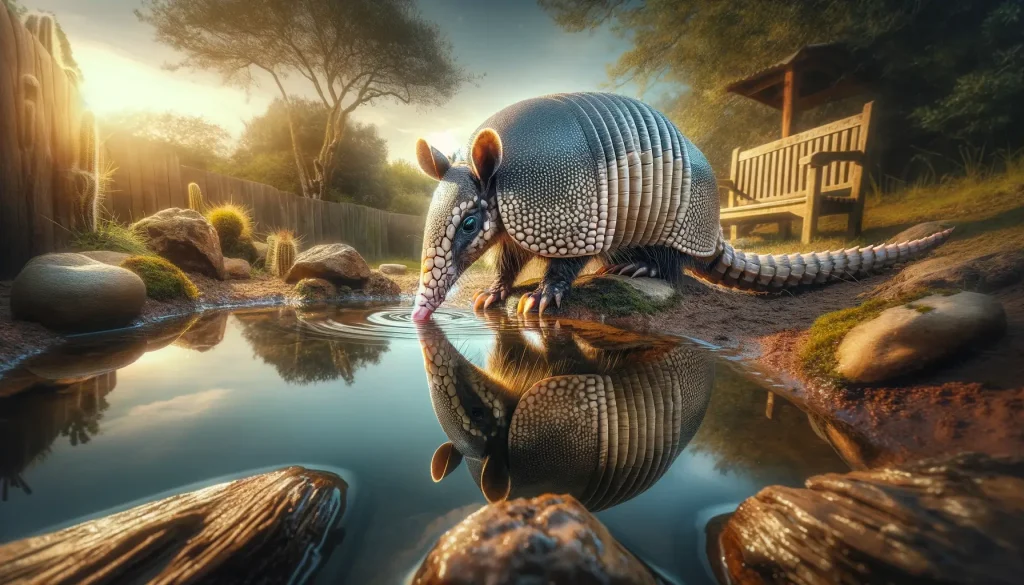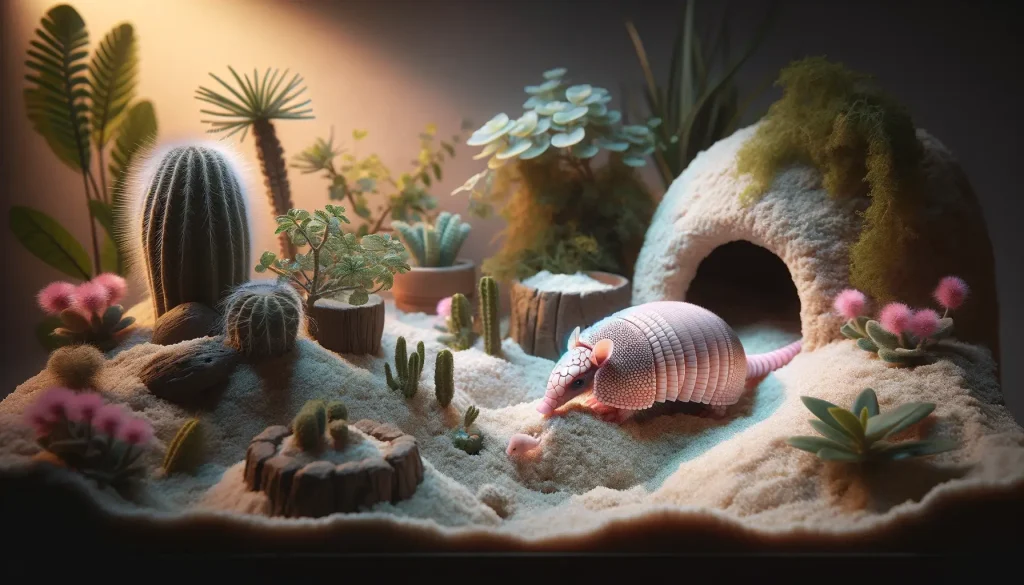
Pet armadillos are unique and becoming increasingly popular among exotic pet enthusiasts. Originating from tropical and subtropical areas in Central and South America, these armored mammals are part of the family Dasypodidae. Before deciding to keep an armadillo as a pet, it’s crucial to understand their characteristics, needs, and the care they require.
Armadillos have a distinctive shell, known as the carapace, covering much of their body, including their head, legs, and tail in most species. This carapace consists of bony transverse bands encased in tough scales, a unique feature among mammals. They vary significantly in size, from the petite pink fairy armadillo, measuring just about 16 cm (6 inches), to the impressive giant armadillo, which can grow up to 1.5 meters (5 feet) in length and weigh 30 kg (66 pounds).
Armadillos exhibit fascinating behaviors when threatened, including retreating to their burrows or, for three-banded armadillos, rolling into a ball. The nine-banded armadillo, which is the only species found in the United States, is known for its unique defense mechanism of leaping vertically into the air. Moreover, this species is notable for giving birth to identical quadruplets from a single fertilized egg, a rare trait termed polyembryony.
Before welcoming an armadillo into your home, it’s critical to research and ensure you can meet their unique needs. These fascinating creatures require dedicated care to thrive in a domestic setting, making them suitable for experienced and committed exotic pet enthusiasts.
Fun Facts About Your Armored Companion
Armadillos are as fascinating as they are unique. Here are some fun facts about these armored mammals to better appreciate your quirky pet.
- Natural armor: Armadillos have a carapace that acts as natural armor. This protective shell is composed of bony plates covered in tough scales. It’s their signature trait.
- Diverse family: There are 20 different species of armadillos. Sizes range from the tiny pink fairy armadillo at just 16 cm to the giant armadillo, reaching up to 1.5 meters and weighing 30 kg.
- Aquatic abilities: Surprisingly, armadillos can hold their breath underwater for up to six minutes. They can swim by inflating their stomachs and intestines with air, which makes them buoyant.
- Identical quadruplets: The nine-banded armadillo is known for giving birth to identical quadruplets from a single fertilized egg, a phenomenon called polyembryony.
- Exceptional diggers: Armadillos use their strong, curved claws to dig extensive burrows, which can be up to 6 meters (20 feet) long. These burrows serve as homes and are a means of escaping predators.
- Leaping defense: When startled, the nine-banded armadillo can leap vertically into the air. This unexpected jump can surprise predators and humans alike.
- Nighttime foragers: Mostly active at night, armadillos have a diet consisting of termites, insects, small animals, and vegetation. Their nocturnal habits help them avoid the heat and predators.
Armadillos are more than just pets with unique armor; they are creatures with intriguing behaviors and abilities. From their swimming skills to the birth of quadruplets, armadillos are sure to surprise you. Getting to know these facts can deepen your appreciation and understanding of your pet armadillo’s needs and natural instincts.

Ideal Habitat for Your Armadillo
Providing a comfortable and appropriate habitat is crucial for your pet armadillo’s health and happiness. Armadillos are adapt creatures used to digging and foraging, so their living space should mimic their natural environment as closely as possible.
Outdoor Enclosures
If you have the space, an outdoor enclosure works best. Ensure it is large enough, with a minimum size of 6×3 meters (20×10 feet), to allow your armadillo to exhibit natural behaviors. The enclosure should include a mix of soil and sand for digging, along with vegetation and hiding places to simulate a natural habitat. Secure fencing, dug into the ground, is necessary to prevent escapes.
Indoor Housing
For indoor housing, a large, secure pen with deep bedding of safe soil or sand allows for digging and burrowing. Include a hide box for privacy and ensure the room is well-ventilated and kept at a temperature between 24-27°C (75-80°F), mimicking their warm natural environment. The area should be quiet and away from direct sunlight.

Diet and Nutrition for Armadillos
Armadillos’ diet in the wild mainly consists of insects, small vertebrates, and plant matter. Replicating this diet as closely as possible is vital for their health.
- A balanced diet includes live insects such as mealworms, beetles, and crickets, to mimic their natural insectivorous tendencies.
- Offer a variety of fruits and vegetables to ensure they receive necessary vitamins and minerals. Small amounts of cooked meat can also be given occasionally.
- Ensure clean, fresh water is always available.
Consulting with a veterinarian experienced in exotic animals is recommended to tailor a diet to your pet’s specific needs, especially considering the variety in armadillo species.
Health Care and Maintenance
Regular veterinary check-ups are essential for keeping your pet armadillo healthy. Armadillos can carry diseases such as leprosy, and regular health screenings can prevent disease transmission to humans. Here are some preventive measures:
- Annual health exams, including parasite checks and vaccinations as recommended.
- Maintain a clean living environment to prevent disease.
- Monitor your pet for signs of illness, such as lethargy, lack of appetite, or unusual behavior.
With the right care, diet, and environment, your pet armadillo can lead a healthy and stimulating life. Remember, owning an armadillo requires a significant commitment and understanding of their unique needs.

Armadillo Interaction and Socialization
Understanding the interaction and socialization needs of your pet armadillo is key to ensuring its well-being. While armadillos are mostly solitary creatures, their behavior toward humans and other animals can vary depending on the species and individual personality.
Social Behavior
Most armadillos, including the nine-banded armadillo, live alone and are not highly social animals. They spend a significant amount of time foraging for food, digging burrows, or resting. However, in a domestic setting, armadillos can exhibit a range of behaviors from shy and withdrawn to curious and interactive, depending on their environment and handling.
Handling Your Armadillo
Gentle and regular handling from a young age can help your armadillo become more comfortable with human interaction. It’s important to move slowly and speak softly around them to avoid startling them. Remember, sudden movements can trigger their defensive mechanisms, such as retreating into their shell or burrow.
Armadillos have poor eyesight but a strong sense of smell. Allowing them to smell your hand before attempting to pet or pick them up can help in gaining their trust. Use treats to encourage positive associations with handling.
Environment Enrichment
To stimulate your armadillo’s natural behaviors, providing a variety of environmental enrichments is beneficial. Incorporate elements such as:
- Safe digging areas: Areas filled with sand or soil mimic their natural habitat and satisfy their need to dig.
- Hiding spots: Small shelters or hide boxes within their enclosure allow them to retreat when they feel threatened or need rest.
- Foraging opportunities: Hiding food or treats throughout their enclosure can encourage their natural foraging behavior.
Despite their solitary nature, some armadillo species may tolerate or even enjoy the company of their human caretakers with time and patience. Observing your armadillo’s reactions and adjusting your interactions accordingly is crucial.
Introducing armadillos to other pets should be done with caution and under close supervision. Due to their unique needs and potential for disease transmission, such as leprosy, direct contact with other animals is generally not recommended.

Legal and Ethical Aspects of Pet Armadillos
When considering bringing an armadillo into your family, it’s crucial to understand the legal and ethical implications. Not all regions allow armadillos as pets, and special permits might be required. It’s important to ensure that you are not contributing to the illegal wildlife trade, a concern that impacts many exotic animals.
Legal Considerations
First, check local and state regulations regarding exotic pets. In some places, it’s illegal to own an armadillo. This is often due to concerns about diseases, such as leprosy, which armadillos can carry, and the potential environmental impact if they escape into the wild. If armadillos are legal in your area, you may need a permit or a license to keep one.
Ethical Considerations
Armadillos have specific needs that can be challenging to meet in a home setting. They are wild animals, and their well-being should be a priority. Consider whether you can provide a naturalistic environment, proper diet, and the space they need to exhibit natural behaviors.
Responsible Ownership
Should you decide that an armadillo is a right pet for you, ensure you acquire one responsibly. Purchase or adopt from reputable sources that can verify the armadillo was bred in captivity and not taken from the wild. This helps discourage the illegal pet trade and ensures you’re not contributing to the decline of wild populations.
Additionally, armadillos require specialized veterinary care. Finding a vet experienced with exotic animals is essential before bringing an armadillo home. This ensures your pet will receive proper healthcare throughout its life.
Beginner Guide to Raising Quail at Home
What are the Signs of a Dog Concussion?
What Causes Your Dog’s Ears to Smell Bad?
When your dog’s ears start to emit an unpleasant odor, it might leave you puzzled…
Methimazole Treatment for Cat Hyperthyroidism
Methimazole plays a crucial role in managing feline hyperthyroidism, a condition marked by an overactive…
Got Hummingbirds in your Backyard? Here’s How to Care for Them.
Why Does Your Cat Pee Outside the Litter Box?
Cat’s Litter Box Issues It’s not uncommon for cat owners to face the frustrating dilemma…




